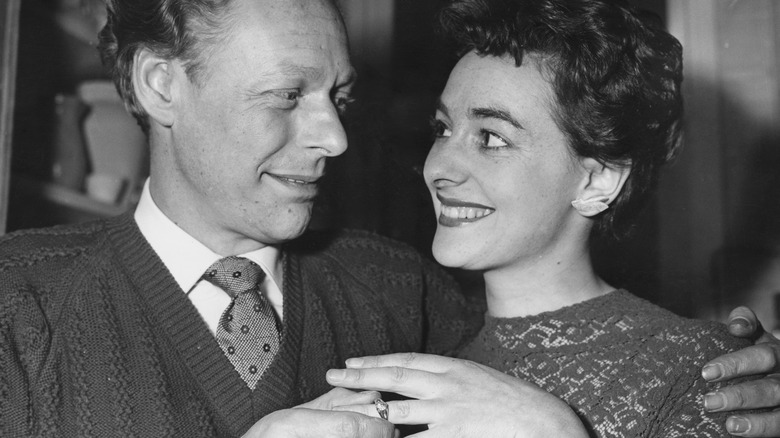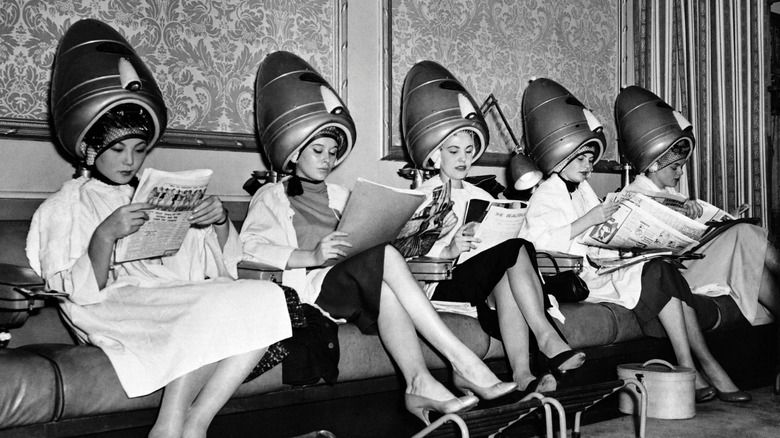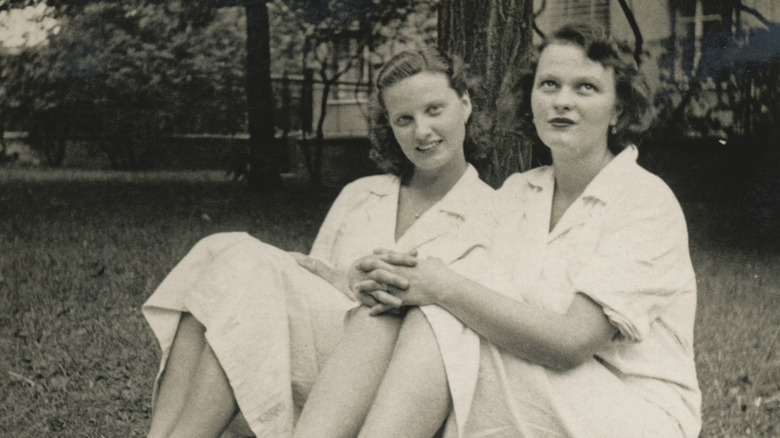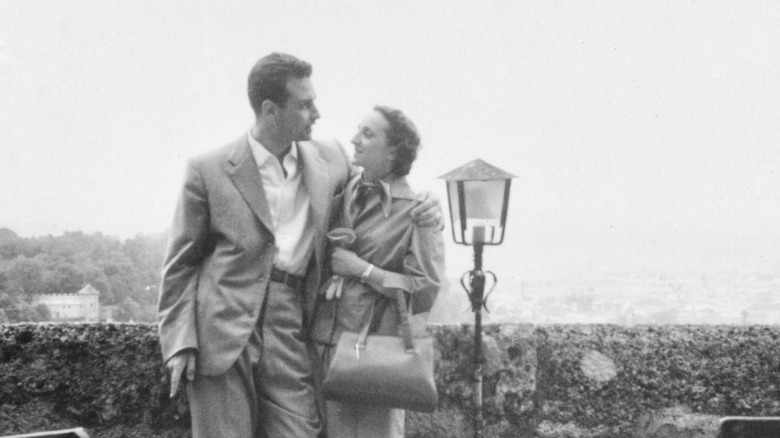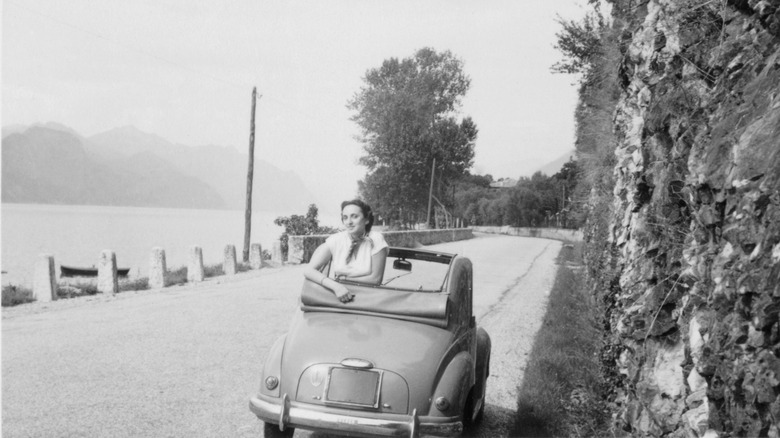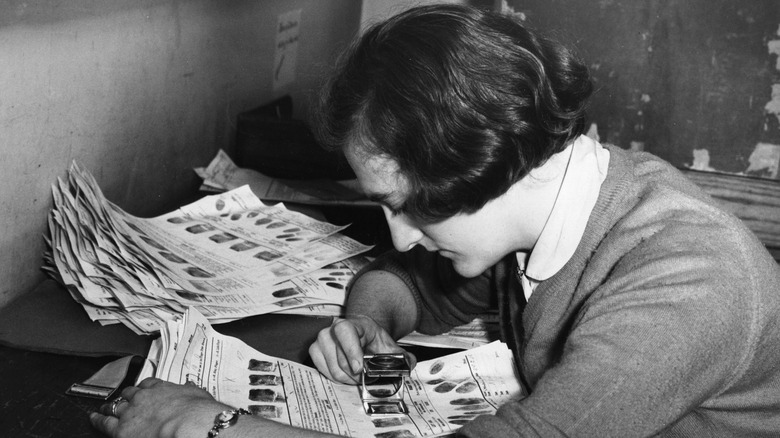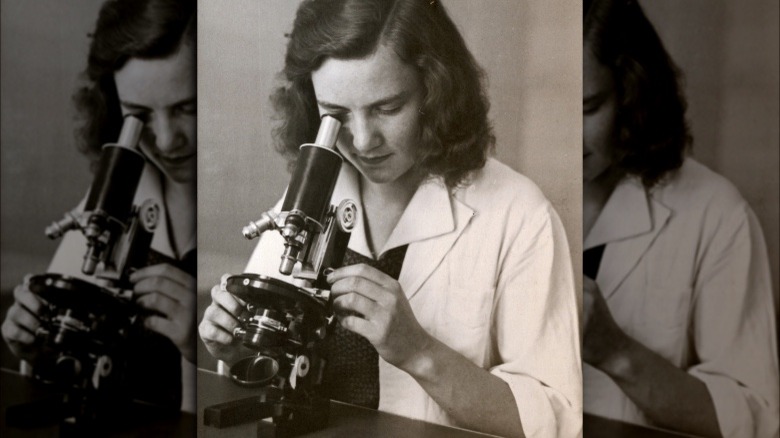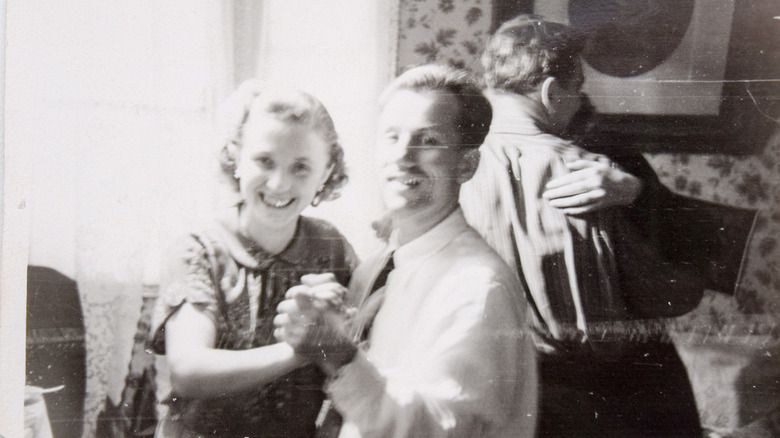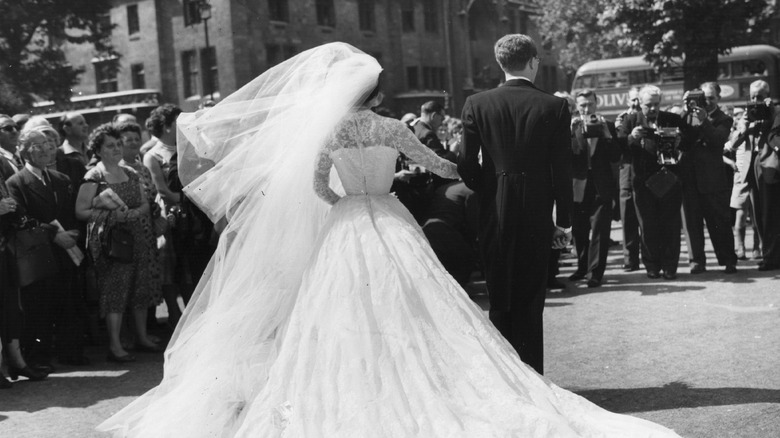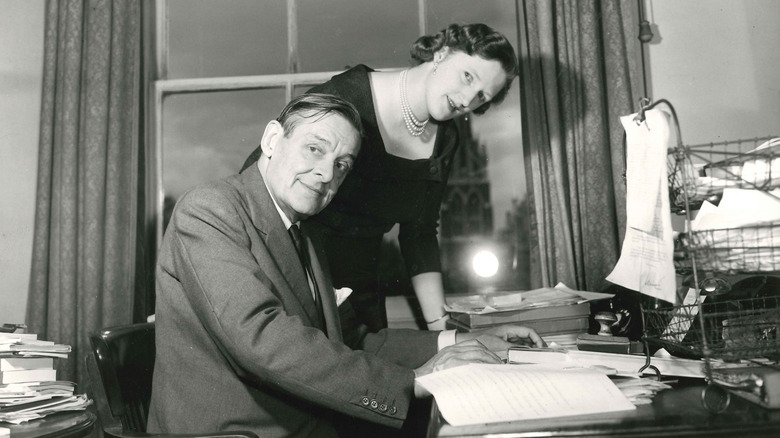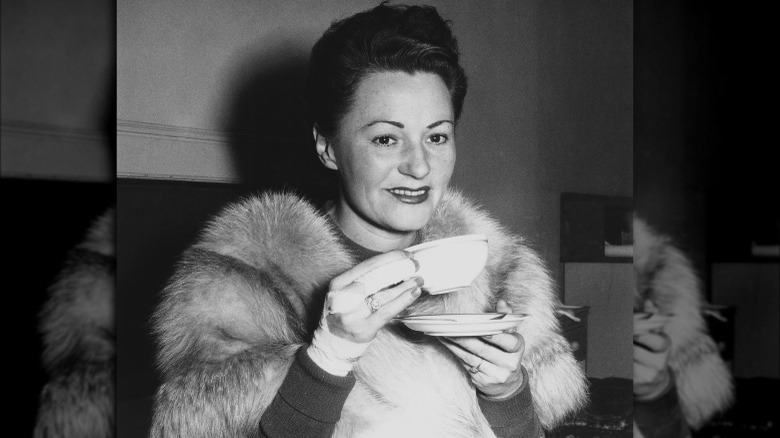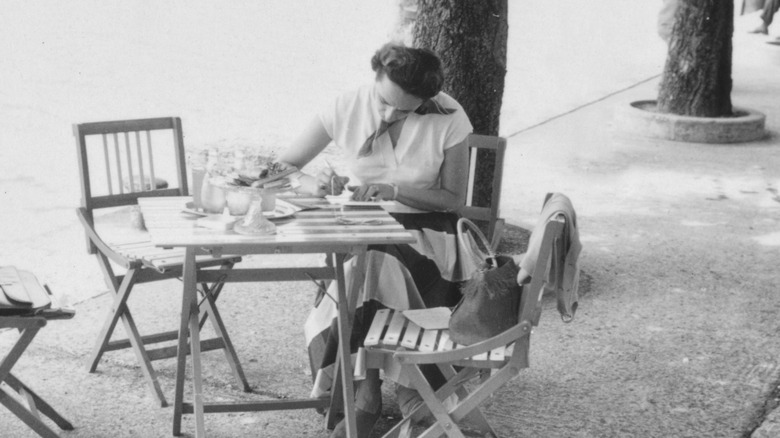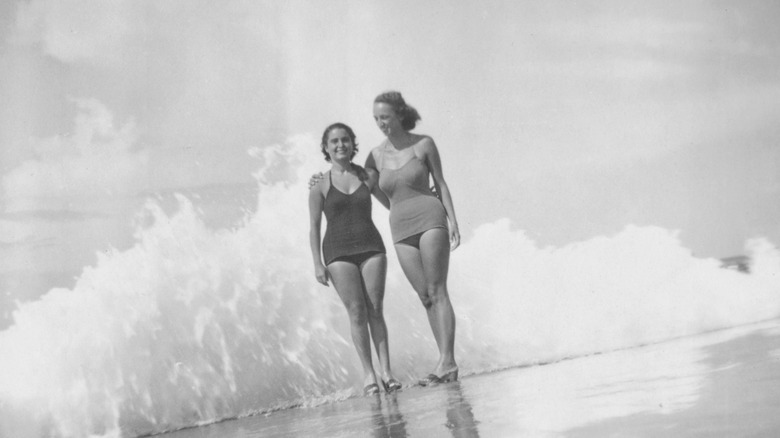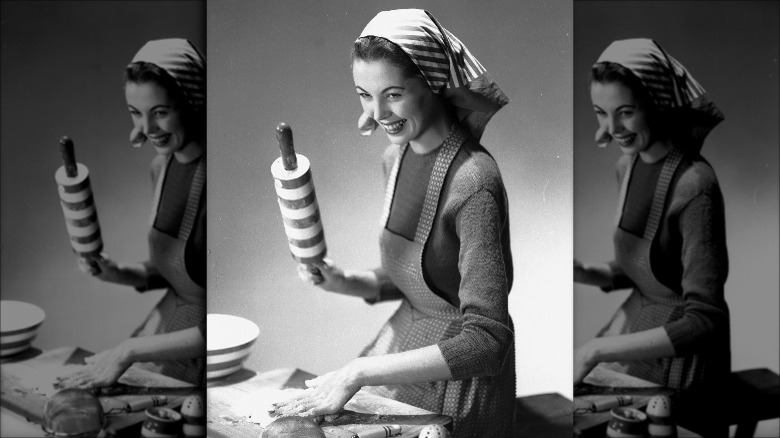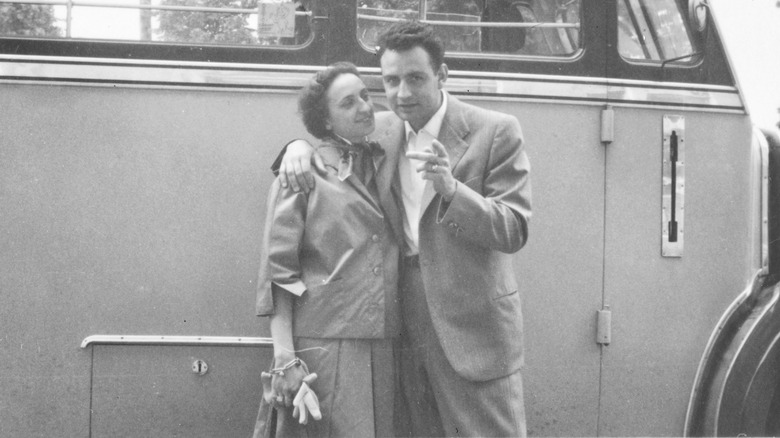Bizarre Ways Women Were Encouraged To Find A Husband In The 1950s
If you were a teenage girl in the 1950s, you may have spent a lot of time daydreaming about going steady with one of the boys in your grade. You could only hope that one day, if you were lucky, he might just gift you his varsity letterman jacket — a symbol to all your friends that you're "taken." Of course, whether this dream was actually yours or whether it was dreamt up by society, well, that's a horse of a different color.
Regardless, dating has changed a lot since the '50s, and, while we may all be enthralled with mid century modern furniture and episodes of Mad Men, most women today would probably agree that they'd never want to go back to the patriarchal ways that so dominated the era. And although you can get modern-day advice on how to find a husband, there's just nothing that can quite compare to the suggestions dispensed in women's magazines circa the 1950s. Here's some of the most hilarious, horrifying, and just plain bizarre guidance of the time.
Check the obituaries
When Kim Marx-Kuczynski, a Wisconsin resident stumbled upon a rare gem: a 1958 issue of McCall's Magazine. Featured in this edition of the popular women's magazine was the article "129 Ways to Get a Husband." According to photos of the article shared to Facebook, these ways were thought up by a panel of experts — both men and women. "In the United States today there are sixteen million women over the age of seventeen who are not married," the feature read. "Presumably the vast majority of them would like to be."
Throughout the article, women were encouraged to set their sights on husbands whose wives had passed away. "Read the obituaries to find eligible widowers," one tip read. Another: "Go to all reunions of your high school or college class. There may be widowers there." Oh, but if you happen to be widowed or divorced yourself — gasp! — the article advises you not to "constantly discuss your former husband." But of course.
Be careful not to act "unbecomingly"
McCall's wasn't the only women's magazine doling out some truly questionable advice. In 1952, Modern Bride dispensed some interesting tidbits. According to Jezebel, this particular edition featured a booklet — "a book condensation of Preparing for Marriage, the guide to marital and sexual adjustment" by Clifford R. Adams, a psychology professor and "nationally famous Marriage Counselor" —which was stapled into the back of the magazine. And Adams had some pretty cringe-worthy thoughts about how modern brides should behave.
"Will this mate embarrass you by nonconformity?" the psychologist asked readers. "The man wants a wife who will not act unbecomingly in public, who knows how to say and do the right thing when other people are present..." Oh boy. While this advice may have been thought of as normal and solid guidance back in the '50s, there's no doubt that it'll leave you scratching your head now.
Work for that engagement
Although women proposing to their male partners is still a fairly rare occurrence, it would've been practically unheard of during the mid century. But don't assume that means women were just twiddling their thumbs while awaiting a ring. Oh, no. "It is up to you to earn the proposal," said the article "How to Make Him Propose" in the 1951 issue of the women's magazine Coronet (via Making Marriage Work). According to the then-sage advice, this could be done "by waging a dignified, common-sense campaign designed to help him see for himself that matrimony rather than bachelorhood is the keystone of a full and happy life."
During this time in history, it was commonly believed that "women had much more to gain from marriage than did men," according to the book Making Marriage Work: A History of Marriage and Divorce in the Twentieth-Century United States. With the invention of Playboy magazine in 1953, men allegedly only became more enamored by bachelorhood as opposed to marriage.
Jeopardize your car and your safety
The advice given to single women in the 1950s was not only riddled with sexism, but it could also be outright dangerous. "Have your car break down at strategic places," McCall's Magazine (via Facebook) advised women who were looking for a potential spouse in 1958. Sorry, what's that now? This straight-out-of-a horror-movie piece of advice sounds like a better way to trap a serial killer than a husband. In addition to reinforcing the damsel in distress trope, being approached by a strange man is also likely the last thing you would want to happen if your car breaks down. So, to strategically make it happen? Terrifying!
Modern day wisdom outlines a much safer solution if your car happens to break down. "If a motorist stops to render assistance, it's better to remain in the car and ask him to call for or get help," Corporate Travel Safety advises. "You can use your phone camera to record the conversation."
Get an "Mrs." degree
It was common for women in the '50s to get hitched soon after finishing high school or while attending college. From 1947 all the way up to 1972, the median age for a first marriage was at some point during a woman's 20th year of life, according to the U.S. Bureau of the Census. But, in 1956, it hit the lowest it had ever been — and would ever be — since census data began being collected. Many women were barely 20 — 20.1, to be exact — when tying the knot.
So many young women were getting married during their early college years, in fact, that it became a sort of running joke that women who went to college at that time were pursuing an "Mrs." (pronounced "M.R.S.") degree. "Although women had other aspirations in life, the dominant theme promoted in the culture and media at the time was that a husband was far more important for a young woman than a college degree," PBS's "Mrs. America: Women's Roles in the 1950s" explained.
Hide your brilliance
If you're curious to know what men were looking for back in the mid century, psychologist and marriage counselor Clifford R. Adams' Preparing for Marriage booklet circa 1952 (via Jezebel) has you covered. "The average man marries a woman who is slightly less intelligent than he is," he began. "That's why many brilliant women never marry." Feel free to take a minute to laugh uproariously. Whew! Okay, let's continue.
According to Adams, these smart ladies who have yet to get married either "do not come in contact with sufficiently brilliant men" or "fail to disguise their brilliance in order to win a man of somewhat less intelligence." It has been his experience, he went on to reveal, that college-aged men want to marry women who are smart, yes, but not so smart that it makes them feel less intelligent. That's right, he is essentially saying that it is okay — nay, preferable — to play dumb.
Pursue other women's "leftovers"
Dating the ex-partner of one of your friends can get super complicated. But that's not saying that it can't work. "Finding yourself attracted to a friend's ex doesn't mean you're a villain," Brandy Engler, psychologist and author of The Women on My Couch, told Women's Health. If you're trying to pursue a new romantic relationship while maintaining a friendship, Engler revealed that a lot of it comes down to communication and your friend's feelings on the matter. "If your friend isn't over it and is still actively requiring your support, it's not very ethical to go in," she explained.
Since this situation is known to get messy — even with acquaintances as opposed to besties — it's that much more outlandish that it was passed around as good advice in 1958. McCall's Magazine (via Facebook) advised, "Don't be afraid to associate with more attractive girls; they may have some leftovers." While falling for your friend's ex certainly doesn't make you a bad guy, as Engler said, befriending "more attractive girls" to snag their "leftovers" sounds a bit, well, vulturous.
Leave your man and find someone new
You could say that being married was regarded as more important in the 1950s than who you married. Psychologist Clifford R. Adams, being the esteemed marriage guru of the time, ran a column called "Making Marriage Work" in Ladies' Home Journal (via one student's research at the University of Wisconsin) in the early '50s.
In 1951, one woman wrote in for advice and revealed that she and her boyfriend had been in a relationship for six years, but he hadn't yet proposed. Equipped with only the knowledge provided to him, Adams made his armchair diagnosis: The woman's boyfriend was "too emotionally immature and not ready for marriage." Adams wrote that the woman should end the relationship and pursue someone (seemingly anyone) who is ready to get married.
The following year, Adams continued to prescribe marriage as the be-all, end-all for women. When a woman asked if she should hope to marry her current boyfriend, Adams replied, "Marriage is a dream for any [woman] ... Planning a wedding is what every woman looks forward to once she is engaged."
Stay away from certain artists
According to the 1952 booklet in Modern Bride (via Jezebel), "girls who will be happy in marriage enjoy teaching children and have a fondness for old people." Okay then. But that's not at all. "They are not strong admirers of musicians and poets though they may like good music or poetry," the booklet read. It's all about priorities, it seems. As getting married and having children went hand-in-hand during the baby boom era, possessing care-taking abilities surely proved that a woman was not only able to take care of her spouse, but also her future children. Because, yes, of course she would have children.
Both men and women were further cautioned: "Beware a person who shows a neurotic tendency, unconventional behavior, a craving for excitement, an urge to be constantly on the go." Hmm, do you think these tendencies and behaviors are the result of playing music and writing poetry? Apparently Footloose should've been set in the 1950s.
Throw on a Band-Aid
Many of the ways women were encouraged to find husbands in the post-war era were just hilarious — and some were pretty harmless. "Wear a Band-Aid," McCall's Magazine (via Facebook) advised in 1958. "People always ask what happened." Yes, it's a lie, albeit a little white lie, but we get it. It's a conversation starter in its own right. Though if a woman's asked, she better come up with a backstory for her made-up injury fast. Oh, what a tangled web women were encouraged to weave!
McCall's also suggested other ways to get the conversation flowing. "Dropping the handkerchief still works," the article revealed. Scandalous. "Walk up to him and tell him you need some advice," the magazine noted. While most of these are fairly innocuous, there is one conversation starter that really hasn't aged well: "Stand in a corner and cry softly. Chances are good that he'll come over to find out what's wrong."
Ditch the "mannish styles"
Gender-neutral fashion may be all the rage these days, but, in the 1950s, women were strongly encouraged to dress in a way that drew attention to their physical form. "Mannish styles like severely tailored suits and harsh hats do not enhance a woman's physical appearance," an issue of Ladies' Home Journal (via the University of Wisconsin) read. This advice fed into the retro idea that women who weren't yet married must've been largely responsible for their singleness. "Once a woman hits [30] her chances of finding men within her age group are very slim unless she made some fundamental changes to herself," psychologist Clifford R. Adams wrote in the '51 edition. If only they didn't wear so many suits, right?
The psychologist opined that women should aim to be more feminine, for that just had to be the key to finding and keeping a husband. Spoiler alert: It's not.
Sit out in the sun
For some reason, a panel of experts — or so they claim to be — thought it would be a good idea to advise women in 1958 to "get a sunburn." The only context that can be used to understand this is that the advice is situated under the subheading "How to Look Good to Him." Eek. Perhaps getting a sunburn was a way to start a conversation, but, more than likely, this was a symbol of a certain lifestyle.
According to Town & Country, Coppertone sunscreen became "immensely popular" during the 1950s thanks to its cheeky ad campaign. At around the same time, photographer Slim Aarons started photographing the rich and famous in "places of leisure" — which were then featured in women's magazines throughout the '50s. Although Coppertone's catchphrase of the time was "tan, don't burn," a sunburn was probably a pretty good indication that you lived a life of leisure — at least some of the time.
You better cook well
If you were a woman who was hoping to get married in the 1950s, there's a good chance you took up cooking. Just as children weren't seen as optional back in the mid century, neither was knowing one's way around the kitchen. "With common sense and a good cookbook a bride soon learns to prepare adequate meals," the January 1955 issue of Ladies' Home Journal (via the University of Wisconsin) declared. Naturally, good judgement and cooking were on par with each other.
During this era, cooking was seen as "women's work." According to the article "Exploring the Domestic Ideology of the Postwar Era through Cookbooks," cookbooks in the '50s were geared solely toward housewives and "new brides." The recipes provided were so women could "best satisfy her husband's taste palette" and demonstrated "how wives could help their spouses by offering small gestures of love, namely by fussing over his food or drink."
Time to conform
Being a woman in the 1950s was all about following the rules and, naturally, not making any waves. Except with your hair, of course. In the "Preparing for Marriage" booklet in the 1952 issue of Modern Bride (via Jezebel), "the man" is said to desire a woman and eventual wife "who will conform to the customs that will cause their neighbors to think well of her." Life is, after all, all about what the neighbors think, right?
Living in any way that was counterculture — especially when it came to gender roles — was apparently not a way to catch a husband. Psychologist Clifford R. Adams' booklet revealed that it was "particularly" important for women to "conform to the norms set by society." The booklet continued, "Not liking to be 'different,' she wants her marriage to meet community standards." Hmm. The 1950s were truly full of mad men, eh?
